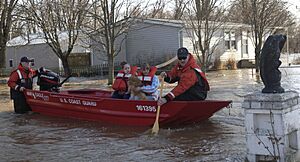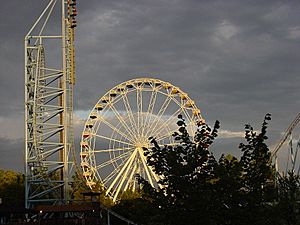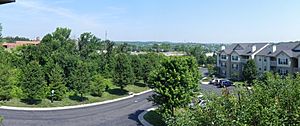Eureka, Missouri facts for kids
Quick facts for kids
Eureka, Missouri
|
|
|---|---|
|
City
|
|

Eureka's main street
|
|
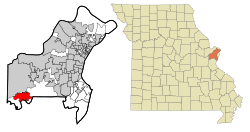
Location of Eureka, Missouri
|
|
| City | Eureka |
| State | Missouri |
| Counties | St. Louis, Jefferson |
| Area | |
| • Total | 11.22 sq mi (29.06 km2) |
| • Land | 11.05 sq mi (28.62 km2) |
| • Water | 0.17 sq mi (0.44 km2) |
| Elevation | 476 ft (145 m) |
| Population
(2020)
|
|
| • Total | 11,646 |
| • Density | 1,053.75/sq mi (406.85/km2) |
| Time zone | UTC−6 (Central (CST)) |
| • Summer (DST) | UTC−5 (CDT) |
| ZIP code |
63025
|
| Area code(s) | 636 |
| FIPS code | 29-22834 |
| GNIS feature ID | 2394707 |
| Website | City of Eureka official website: http://www.eureka.mo.us/ |
Eureka is a city in Missouri, mostly located in St. Louis County. A small part of it is in Jefferson County. It is close to the cities of Wildwood and Pacific. Eureka is in the far southwest part of the larger Greater St. Louis area.
In 2020, about 11,646 people lived in Eureka. The city is also famous for being home to the Six Flags St. Louis amusement park since 1971.
Contents
History of Eureka
The first people known to live in this area were the Shawnee Native Americans. They lived along the Meramec River. Even today, you can find old tools and items, called archaeological artifacts, that show they once lived there.
The town of Eureka was planned out in 1858. It was built along the path of the Pacific Railroad. By 1890, there were about 100 homes in the village. When railroad workers were clearing land for the tracks, they found a flat area that was easy to build on. They shouted "Eureka!" which is a Greek word meaning "I've found it!" This is how the city got its name.
In 1898, the St. Louis Children's Industrial Farm opened in Eureka. This farm gave children from crowded city neighborhoods a chance to experience life in the countryside. It later became Camp Wyman, which is now part of the Wyman Center. It is one of the oldest camps in the United States. The first high school class in Eureka was held in 1909. Eureka officially became a city on April 7, 1954.
Originally, Eureka was only in St. Louis County. However, in 2019, the city decided to add some land from Jefferson County. This included a large area with a sand and gravel quarry and another field. Later that year, they also added a new neighborhood called Windswept Farms. These changes helped the city grow.
Allenton: A Former Town
The railroad town of Allenton was a community located where Interstate 44 and Business Loop 44 meet today. In 1985, the city of Eureka officially took over Allenton, which is called annexation. Today, this area is mostly rural with farms and forests.
Geography and Floods
Eureka covers about 10.45 square miles (27.07 square kilometers). Most of this area is land, with a small part being water.
Major Floods in Eureka
The city of Eureka has experienced several floods. Two of the biggest floods happened in 2015 and 2017. These floods caused the city and the U.S. Army Corps of Engineers to look for ways to prevent future flooding. They considered building levees (walls to hold back water) and flood walls, buying properties in high-risk areas, and restoring flood plains (flat land next to a river that floods easily) to help store water.
Scientists have suggested that some of the flooding might have been made worse by human actions. They believe that old flood risk maps did not accurately predict how the river would behave, leading to buildings being constructed in areas that should have been left open for floodwaters.
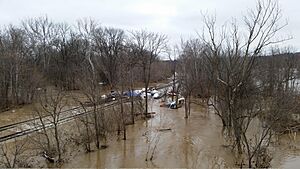
The 2015 Flood
In December 2015, a big storm brought heavy rain and snow to Missouri. This caused severe floods. Some parts of the state received over 10 inches (250 mm) of rain. In Eureka, the Fire Department had to rescue more than 100 people and several pets from the second floors of their homes near the Meramec River. They used boats to reach those who were trapped by the rising water.
The 2017 Flood
Another major flood happened in April 2017. A strong spring storm brought many thunderstorms and heavy rain to the Midwest. The Mississippi River reached near-record flood levels. In Eureka, a church's first floor was flooded with about 48 inches (120 cm) of water, similar to the 2015 flood. The floodwaters from the Meramec River also covered the athletic fields at Eureka High School. The water even reached the school buildings and damaged the gymnasium floor.
Population Changes
| Historical population | |||
|---|---|---|---|
| Census | Pop. | %± | |
| 1880 | 141 | — | |
| 1960 | 1,134 | — | |
| 1970 | 2,384 | 110.2% | |
| 1980 | 3,862 | 62.0% | |
| 1990 | 4,683 | 21.3% | |
| 2000 | 7,676 | 63.9% | |
| 2010 | 10,189 | 32.7% | |
| 2020 | 11,646 | 14.3% | |
| U.S. Decennial Census | |||
The population of Eureka has grown a lot over the years. In 1880, only 141 people lived there. By 2020, the population had grown to 11,646 people.
What the 2020 Census Showed
The 2020 United States census counted 11,646 people living in Eureka. Most residents, about 90.73%, identified as white. There were also people of other backgrounds, including African American, Native American, Asian, Pacific Islander, and people of two or more races. About 2.1% of the population identified as Hispanic or Latino.
There were 3,486 households in the city. About 40.5% of these households had children under 18 living with them. The average household had about 2.8 people. The average age of people in Eureka was about 39.8 years old.
Education in Eureka
The Rockwood R-Vi School District runs the public schools in Eureka. This includes three elementary schools, Lasalle Springs Middle School, and Eureka High School.
There are also two private schools in the city: St. Mark's Lutheran Church and School, and Most Sacred Heart Church and School.
For reading and learning, the city has the Eureka Hills Branch lending library. This library is part of the St. Louis County Library system and moved to a new building in 2021.
Local News
People in Eureka can read local news from several sources. These include the Tri-County Journal, the Eureka and Pacific Current NewsMagazine, and the Washington Missourian.
Famous People from Eureka
- Clayton Echard, a former football player and star of The Bachelor TV show.
- Cam Janssen, a professional National Hockey League player.
- Bob Klinger, a former Major League Baseball player.
- Rissi Palmer, a country music singer.
See also
 In Spanish: Eureka (Misuri) para niños
In Spanish: Eureka (Misuri) para niños



